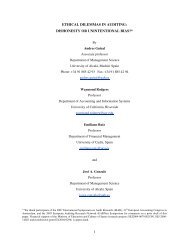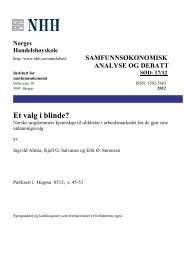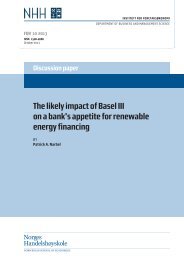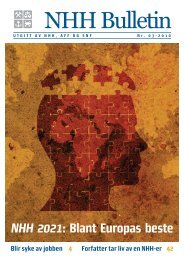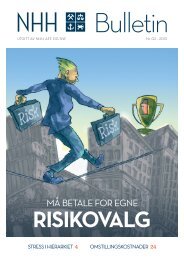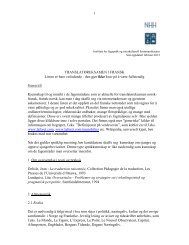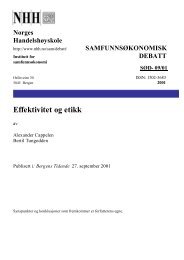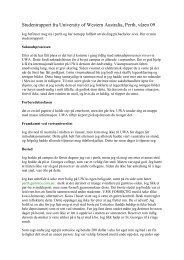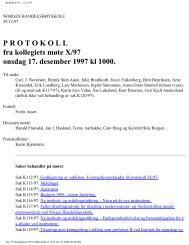In the Wake of Tønnessen and Johnsen - NHH
In the Wake of Tønnessen and Johnsen - NHH
In the Wake of Tønnessen and Johnsen - NHH
You also want an ePaper? Increase the reach of your titles
YUMPU automatically turns print PDFs into web optimized ePapers that Google loves.
<strong>In</strong> <strong>the</strong> <strong>Wake</strong> <strong>of</strong> <strong>Tønnessen</strong> <strong>and</strong> <strong>Johnsen</strong>:<br />
Trends in Whaling History Research after 1970<br />
Bjørn L. Basberg<br />
Economic History Section / Department <strong>of</strong> Economics<br />
The Norwegian School <strong>of</strong> Economics <strong>and</strong> Business Administration<br />
N-5045 Bergen<br />
20. September 2005<br />
Abstract<br />
1<br />
Discussion Paper 19/05<br />
<strong>In</strong> 1970 <strong>the</strong> fourth <strong>and</strong> final volume <strong>of</strong> Arne Odd <strong>Johnsen</strong> <strong>and</strong> Joh. N. <strong>Tønnessen</strong>s’s Den<br />
moderne hvalfangsts historie was published. The work represented a milestone in <strong>the</strong> writing<br />
about <strong>the</strong> development <strong>of</strong> <strong>the</strong> 20 th century whaling industry.<br />
This paper reviews <strong>the</strong> literature that has been published in Norway <strong>and</strong> internationally on <strong>the</strong><br />
history <strong>of</strong> modern whaling after <strong>Johnsen</strong> <strong>and</strong> <strong>Tønnessen</strong>, <strong>and</strong> analyses <strong>the</strong> focus, trends <strong>and</strong><br />
direction in <strong>the</strong> research <strong>and</strong> writing on whaling history in <strong>the</strong> period.
<strong>In</strong> <strong>the</strong> <strong>Wake</strong> <strong>of</strong> <strong>Tønnessen</strong> <strong>and</strong> <strong>Johnsen</strong>:<br />
Trends in Whaling History Research after 1970<br />
<strong>In</strong>troduction 1<br />
<strong>In</strong> 1970 <strong>the</strong> fourth <strong>and</strong> final volume <strong>of</strong> Arne Odd <strong>Johnsen</strong> <strong>and</strong> Joh. N. <strong>Tønnessen</strong>’s Den<br />
moderne hvalfangsts historie was published. Books on <strong>the</strong> history <strong>of</strong> modern whaling had<br />
been published before, both in Norway <strong>and</strong> elsewhere, but this was beyond doubt <strong>the</strong> most<br />
comprehensive effort so far. The books were written from a scholarly perspective <strong>and</strong><br />
represented a great leap forward in <strong>the</strong> “academization” <strong>of</strong> historical writing on this industry.<br />
The volumes also covered in detail an impressive amount <strong>of</strong> topics. As we wrote in <strong>the</strong><br />
introduction to Whaling & History (Basberg, Ringstad <strong>and</strong> Wexelsen (eds.) 1993), <strong>the</strong><br />
younger historians in <strong>the</strong> field - after discovering an interesting piece <strong>of</strong> archival material or<br />
coming up with a fascinating question - <strong>of</strong>ten discovered that <strong>Johnsen</strong> <strong>and</strong> <strong>Tønnessen</strong> had<br />
already found it, <strong>and</strong> given <strong>the</strong> answers. So, <strong>the</strong>ir volumes have been - <strong>and</strong> will be - a basis<br />
<strong>and</strong> a starting point for research on <strong>the</strong> history <strong>of</strong> whaling. There were lacunas, <strong>of</strong> course, <strong>and</strong><br />
new generations <strong>of</strong> historians will have <strong>the</strong>ir new perspectives. The aim <strong>of</strong> this paper is to<br />
review how this has been dealt with by historians during <strong>the</strong> more than thirty years that have<br />
passed since <strong>Tønnessen</strong> <strong>and</strong> <strong>Johnsen</strong>’s work was published.<br />
Den moderne hvalfangsts historie coincided with <strong>the</strong> decline <strong>of</strong> Antarctic large scale whaling.<br />
Since <strong>the</strong>n we have seen new trends in our attitudes to whales <strong>and</strong> whaling. A growing<br />
interest in conservation, <strong>the</strong> environment <strong>and</strong> wildlife has created phenomena such as whale-<br />
watching <strong>and</strong> save-<strong>the</strong>-whale movements. The focus over <strong>the</strong> years has definitely shifted from<br />
whaling to whales. The history <strong>of</strong> <strong>the</strong> whaling industry has been something that many people<br />
wanted to forget about. However, when we look into <strong>the</strong> research <strong>and</strong> writing on whaling in<br />
this period, <strong>the</strong> contributions are never<strong>the</strong>less numerous. <strong>In</strong> <strong>the</strong> following review, I do,<br />
1 This paper was presented as <strong>the</strong> Opening Lecture at The Second Symposium on Whaling & History, Com. Chr.<br />
Christensen’s Whaling Museum, S<strong>and</strong>efjord, September 2005.<br />
A first draft was compiled some years ago, but never completed or published. One important source <strong>of</strong><br />
information <strong>the</strong>n, was a volume <strong>of</strong> Research in Maritime History (No. 9, 1995) edited by F. Broeze that<br />
reviewed <strong>the</strong> research in <strong>the</strong> maritime industry in a number <strong>of</strong> countries, also countries involved in whaling. Of<br />
particular interest were <strong>the</strong> reviews by Hull (Australia), Scholl (Germany) <strong>and</strong> Bruijn (<strong>the</strong> Ne<strong>the</strong>rl<strong>and</strong>s). I also<br />
received valuable input on <strong>the</strong> earlier version from Klaus Bar<strong>the</strong>lmess, Lars U. Scholl, Anthony Dickinson <strong>and</strong><br />
late Per Thoresen.<br />
2
however, not intend to review all this literature. I will only survey publications on modern<br />
whaling, <strong>the</strong> period that started in Norway in <strong>the</strong> 1860s <strong>and</strong> 70s, <strong>and</strong> had its heyday<br />
throughout <strong>the</strong> twentieth century in Antarctic waters. Consequently, I will not deal with<br />
American whaling, although it continued well into <strong>the</strong> 20 th century. 2 I will also limit myself<br />
primarily to <strong>the</strong> economic history <strong>and</strong> general history <strong>of</strong> <strong>the</strong> industry, <strong>the</strong> genre that<br />
<strong>Tønnessen</strong> <strong>and</strong> <strong>Johnsen</strong> <strong>the</strong>mselves belonged to. Consequently, I will not deal with research<br />
<strong>and</strong> writing on biological issues or social science issues like international negotiations<br />
concerning whaling. There is, <strong>of</strong> course, a vast literature in <strong>the</strong>se areas, much <strong>of</strong> which has<br />
been published by <strong>the</strong> <strong>In</strong>ternational Whaling Commission <strong>and</strong> its Scientific Committee. 3<br />
<strong>Tønnessen</strong> <strong>and</strong> <strong>Johnsen</strong> wrote in Norwegian, which, <strong>of</strong> course, limited <strong>the</strong> accessibility <strong>of</strong><br />
<strong>the</strong>ir work. They did, however, later provide an English one volume version <strong>of</strong> <strong>the</strong>ir<br />
publication; The History <strong>of</strong> Modern Whaling (1982). This made <strong>the</strong>ir research available to a<br />
wider group <strong>of</strong> readers. The book was also updated on <strong>the</strong> development in Antarctic whaling<br />
throughout <strong>the</strong> 1970s in a short new chapter 36; The Whaling <strong>In</strong>dustry, <strong>the</strong> Environment <strong>and</strong><br />
Natural Resources, 1972-1978. However, as <strong>Tønnessen</strong> emphasised in <strong>the</strong> preface, <strong>the</strong> book<br />
was an abridged version <strong>of</strong> <strong>the</strong> original Norwegian four volumes, omitting sections <strong>of</strong> mainly<br />
local <strong>and</strong> personal interest in Norway, but also references <strong>and</strong> notes. Those were quite<br />
extensive in <strong>the</strong> Norwegian version, so this is still necessary reading for scholars.<br />
When it comes to o<strong>the</strong>r extensive reviews, no works have been published comparable to<br />
<strong>Johnsen</strong> <strong>and</strong> <strong>Tønnessen</strong>, although a few authors have written large general overviews much<br />
more accessible <strong>and</strong> popular than <strong>the</strong>ir work. For example, Francis’, A History <strong>of</strong> World<br />
Whaling (1990) covers both old-style <strong>and</strong> modern whaling (that he labels “<strong>In</strong>dustrial<br />
whalers”). The same is <strong>the</strong> case with S<strong>and</strong>erson’s very personal account A History <strong>of</strong><br />
Whaling (1993). Ellis’ Men <strong>and</strong> Whales (1991) is a more scholarly written book not only<br />
about whaling, but about whales <strong>and</strong> man’s historical involvement with <strong>the</strong>m. A German<br />
parallell is Weidlich (ed.) Von Walen und Menschen (1992). The already mentioned Whaling<br />
& History also covers a long time span <strong>and</strong> a wide range <strong>of</strong> topics from a number <strong>of</strong><br />
2 There is a continuous <strong>and</strong> diversified flow <strong>of</strong> publications on American nineteenth century whaling, from<br />
bestselling novels like N. Philbrick, <strong>In</strong> <strong>the</strong> Heart <strong>of</strong> <strong>the</strong> Sea (New York 2000) (dealing with an ill fated whaling<br />
voyage <strong>and</strong> cannibalism...) <strong>and</strong> S.J. Naslund, Ahab’s Wife (New York 1999) in one end, to econometric history<br />
focusing on technology in general <strong>and</strong> <strong>the</strong> relationship to economic growth; Davis, L.E., Gallmann, R.E. <strong>and</strong><br />
Gleiter, K. <strong>In</strong> Pursuit <strong>of</strong> Leviathan: Technology, <strong>In</strong>stitutions, Productivity, <strong>and</strong> Pr<strong>of</strong>its in American Whaling,<br />
1816-1906 (Chicago 1997).<br />
3 A recent volume which deals with a number <strong>of</strong> such topics is Pétursdottir (1997).<br />
3
esearchers <strong>and</strong> reflects <strong>the</strong> state <strong>of</strong> research at <strong>the</strong> time <strong>of</strong> publication. Most research <strong>and</strong><br />
writing, however, are limited to specific whaling grounds, specific whaling nations, whaling<br />
companies <strong>and</strong> owners, or specific o<strong>the</strong>r topics. <strong>In</strong> <strong>the</strong> following, I will organise <strong>the</strong> survey<br />
according to such categories.<br />
Research <strong>and</strong> writing focusing on whaling nations <strong>and</strong> companies<br />
<strong>Tønnessen</strong> <strong>and</strong> <strong>Johnsen</strong> covered <strong>the</strong> development <strong>of</strong> <strong>the</strong> whaling industry world wide,<br />
regarding catching grounds <strong>and</strong> participating nations. But inevitably <strong>the</strong> main focus was on<br />
<strong>the</strong> Norwegian part <strong>of</strong> <strong>the</strong> industry. There was a “Norwegian perspective” throughout <strong>the</strong><br />
volumes. <strong>Tønnessen</strong> himself was aware <strong>of</strong> this, <strong>and</strong> wrote in <strong>the</strong> preface <strong>of</strong> his volume II (also<br />
translated <strong>and</strong> included in <strong>the</strong> English version):<br />
Even though <strong>the</strong> work aims to comprise <strong>the</strong> history <strong>of</strong> modern whaling throughout <strong>the</strong><br />
world, Norwegian whaling has been accorded pride <strong>of</strong> place, both because it was <strong>the</strong><br />
Norwegians who initiated modern whaling <strong>and</strong> exercised a hegemony for seventy<br />
years, spreading it thorough out <strong>the</strong> world, <strong>and</strong> because <strong>of</strong> <strong>the</strong> inevitably greater<br />
accessibility to <strong>the</strong> author <strong>of</strong> <strong>the</strong> source material in Norway. Writing in similar detail<br />
<strong>of</strong> whaling all over <strong>the</strong> world would indeed have been <strong>the</strong> work <strong>of</strong> a lifetime.<br />
The fact that <strong>Johnsen</strong> <strong>and</strong> <strong>Tønnessen</strong>’s volumes were especially detailed on <strong>the</strong> Norwegian<br />
development is probably one reason why <strong>the</strong>re later has not been published extensive<br />
Norwegian research monographs covering <strong>the</strong> development <strong>of</strong> <strong>the</strong> entire industry. There are<br />
books, like Bakka (1992) <strong>and</strong> Jacobsen (2003), but <strong>the</strong>y are more popular <strong>and</strong> abundantly<br />
illustrated accounts. They are also dealing only with aspects <strong>of</strong> <strong>the</strong> history; Bakka focusing on<br />
<strong>the</strong> expeditions, companies <strong>and</strong> <strong>the</strong> vessels, Jacobsen focusing on <strong>the</strong> whalers <strong>the</strong>mselves.<br />
Some <strong>of</strong> <strong>the</strong> most important writing in <strong>the</strong> wake <strong>of</strong> <strong>Tønnessen</strong> <strong>and</strong> <strong>Johnsen</strong> has not<br />
surprisingly, been studies <strong>of</strong> o<strong>the</strong>r whaling nations <strong>and</strong> companies that at some point were<br />
active on <strong>the</strong> Antarctic grounds <strong>and</strong> elsewhere throughout <strong>the</strong> modern whaling era. <strong>In</strong>deed, <strong>the</strong><br />
first Antarctic whaling company was established in Argentina; Compañia Argentina de Pesca<br />
Sociedad Anónima, <strong>and</strong> a milestone in <strong>the</strong> research on <strong>the</strong> Antarctic whaling industry has been<br />
Hart’s recent book on this company (2001). As a whaling nation, however, Britain was more<br />
4
important, <strong>and</strong> <strong>the</strong> most significant historical writings from 1970 <strong>and</strong> onwards have no doubt<br />
been related to British Antarctic whaling. The single most important contribution - <strong>and</strong> one <strong>of</strong><br />
<strong>the</strong> most important contributions in recent whaling history research - is Jackson’s The British<br />
Whaling Trade (1978). The book covers both traditional <strong>and</strong> modern twentieth century<br />
whaling, <strong>and</strong> was <strong>the</strong> first complete account <strong>of</strong> Britain’s involvement in <strong>the</strong> industry.<br />
Vamplew’s (1975) history <strong>of</strong> <strong>the</strong> Scottish Salvesen company - at one time <strong>the</strong> world’s largest<br />
whaling company - is a second major contribution to <strong>the</strong> history <strong>of</strong> British modern whaling.<br />
The book covers <strong>the</strong> period from <strong>the</strong> establishment <strong>of</strong> <strong>the</strong> business in Leith in <strong>the</strong> 1850s<br />
through <strong>the</strong> active years <strong>of</strong> Antarctic shore station <strong>and</strong> pelagic whaling.<br />
<strong>In</strong> addition to <strong>the</strong>se major contributions, I will mention <strong>the</strong> following publications<br />
contributing to <strong>the</strong> history <strong>of</strong> British modern whaling. Smith (1993) has shed new light on <strong>the</strong><br />
Scottish whaling by interviewing former whalers. Elliot (1998) has given a valuable addition<br />
to <strong>the</strong> history <strong>of</strong> Salvesen’s whaling operations seen through his own experience as a manager<br />
<strong>and</strong> co-owner <strong>of</strong> <strong>the</strong> company. An autobiography from <strong>the</strong> o<strong>the</strong>r end <strong>of</strong> <strong>the</strong> company’s<br />
hierarchy is Gordon (2004). Although not an active nation in modern whaling, let me also<br />
mention Fairley's (1981) contribution on Irish whaling.<br />
Several o<strong>the</strong>r nations gradually became involved in Antarctic whaling, <strong>and</strong> some <strong>of</strong> that<br />
activity has also been manifested in recent research <strong>and</strong> writing. German whaling has been<br />
extensively covered especially by Bar<strong>the</strong>lmess <strong>and</strong> Scholl. Bar<strong>the</strong>lmess (1989) has written an<br />
in depth analysis <strong>of</strong> German involvement in modern whaling before 1914. He has also (1992,<br />
1993 <strong>and</strong> 2005) syn<strong>the</strong>sised <strong>the</strong> long run development <strong>of</strong> <strong>the</strong> industry throughout <strong>the</strong> twentieth<br />
century, <strong>and</strong> written numerous accounts on German whaling companies <strong>and</strong> whaling<br />
expeditions (1986, 1987, 1988, 1991, 1997, 1998). Scholl in several papers (1988, 1991a <strong>and</strong><br />
1991b) gives a new look specifically at German whaling operations in <strong>the</strong> 1930s. This is also<br />
<strong>the</strong> decade in focus in a book by Winterh<strong>of</strong>f (1974). Bohmert (1982a <strong>and</strong> b) has written <strong>the</strong><br />
history <strong>of</strong> a major German whaling company; der Ersten Deutschen Walfang Gesellschaft.<br />
Reupke (1986) deals with German whaling in <strong>the</strong> period from 1936 to 1956. Schäfer (1984),<br />
in a personal account, describes a whaling season with Südmeer in 1938.<br />
Although Japan in <strong>the</strong> post World War II years became <strong>the</strong> most active whaling nation in <strong>the</strong><br />
Antarctic, <strong>the</strong> recent literature - at least in <strong>the</strong> English language - is scarce. Kall<strong>and</strong> <strong>and</strong><br />
Moeran (1992) have written <strong>the</strong> most comprehensive account. Although <strong>the</strong>ir book is<br />
5
primarily an anthropological study, it also deals in detail with <strong>the</strong> Japanese whaling history in<br />
general, both in local coastal waters <strong>and</strong> in <strong>the</strong> Antarctic. A recent review is Ohsumi (2005).<br />
The Ne<strong>the</strong>rl<strong>and</strong>s - with a long history <strong>of</strong> whaling - also became an Antarctic whaling nation<br />
after World War II. The major company <strong>of</strong> this Dutch re-entry in whaling has been dealt<br />
with by Bruijn (1985) <strong>and</strong> Boot (1987).<br />
Some whaling companies <strong>and</strong> expeditions had <strong>the</strong>ir formal ties with nations that cannot be<br />
described as “whaling nations” as such. As in shipping in general, whaling had its “pirates”<br />
who operated under Flags <strong>of</strong> Convenience. The most well known was no doubt Aristoteles<br />
Onassis <strong>and</strong> his Olympic Challenger fleet operating in <strong>the</strong> 1950s. His short lived career in<br />
what he is supposed to have described as ‘gambling at its most elemental’ has been dealt with<br />
at least in one <strong>of</strong> his many biographies (Evans 1986), but also more scholarly by Bar<strong>the</strong>lmess<br />
(1996). Ano<strong>the</strong>r well known Flag <strong>of</strong> Convenience-pioneer in shipping, <strong>the</strong> Norwegian Erling<br />
Dekke Naess, actually started his career in whaling in <strong>the</strong> 1920s <strong>and</strong> became a pioneer in<br />
flagging out Norwegian whaling companies as well as shipping companies. He has given a<br />
detailed account <strong>of</strong> this period <strong>of</strong> his career in his autobiography (1977).<br />
Research <strong>and</strong> writing focusing on whaling areas <strong>and</strong> grounds<br />
The Antarctic became, <strong>of</strong> course, <strong>the</strong> main whaling area <strong>of</strong> modern whaling on which most<br />
writing <strong>and</strong> research have been devoted. The publications relating <strong>the</strong> major whaling nations<br />
that were mentioned, almost exclusively focused on whaling activities in <strong>the</strong> Antarctic. So,<br />
this area obviously has received continuous attention in <strong>the</strong> wake <strong>of</strong> <strong>Tønnessen</strong> <strong>and</strong> <strong>Johnsen</strong>.<br />
<strong>In</strong> addition, some grounds within <strong>the</strong> larger Antarctic area have received more specific<br />
attention, for example South Georgia. This isl<strong>and</strong> became <strong>the</strong> well known centre <strong>of</strong> early<br />
Antarctic whaling, <strong>and</strong> has consequently also attract <strong>the</strong> attention <strong>of</strong> historians. Although<br />
Hart’s book coveres more than <strong>the</strong> Pesca story, <strong>the</strong> history <strong>of</strong> whaling from <strong>the</strong> isl<strong>and</strong> has not<br />
yet been written in full. But <strong>the</strong> history <strong>of</strong> <strong>the</strong> isl<strong>and</strong> as such, which partly, <strong>of</strong> course, is <strong>the</strong><br />
history <strong>of</strong> <strong>the</strong> introduction <strong>of</strong> modern whaling in <strong>the</strong> Antarctic, has been written by Headl<strong>and</strong><br />
6
(1984) - yet ano<strong>the</strong>r very important contribution from a British scholar. 4 The early legislation<br />
faced by <strong>the</strong> whaling companies is studied by Heyburn (1980). The relationship between<br />
South Georgia's whaling industry <strong>and</strong> <strong>the</strong> associated sealing industry, has been considered by<br />
Dickinson (1993a). Dickinson (1993b) has also studied <strong>the</strong> Japanese whaling at South<br />
Georgia in <strong>the</strong> 1960s - not a very successful operation which marked <strong>the</strong> end <strong>of</strong> <strong>the</strong> whaling<br />
era at that isl<strong>and</strong>. A different direction <strong>of</strong> research on South Georgia is industrial archaeology<br />
related to whaling, <strong>and</strong> <strong>the</strong> former whaling stations have been surveyed <strong>and</strong> studied (Basberg<br />
et.al., 1996, 2004). The data that have been collected represent a new source <strong>of</strong> information<br />
for fur<strong>the</strong>r research on <strong>the</strong>se stations both within aspects <strong>of</strong> economic, technological as well as<br />
social history. Whaling at South Georgia has also been chronicled by those involved, from <strong>the</strong><br />
ex-whaler (Pettersen 1999), to <strong>the</strong> “Antarctic housewife” (Brown 1971). Even <strong>the</strong> chruch in<br />
Grytviken <strong>and</strong> those employed <strong>the</strong>re has now <strong>the</strong>ir history written (Hansen 1999).<br />
The South Shetl<strong>and</strong>s were ano<strong>the</strong>r centre <strong>of</strong> <strong>the</strong> early 20 th century whaling, <strong>and</strong> a few<br />
publications have come out <strong>of</strong> <strong>the</strong> activities <strong>the</strong>re (Hacquebord 1992, Rossnes 1996) ,<br />
especially relating archaeological aspects. The same is <strong>the</strong> case with Kerguelen (Le Mouël<br />
1994), about which also a more general account <strong>of</strong> whaling <strong>and</strong> o<strong>the</strong>r activities has been<br />
published (Arnaud <strong>and</strong> Beurois, 1996).<br />
The Antarctic <strong>and</strong> <strong>the</strong> Sou<strong>the</strong>rn Ocean developed into <strong>the</strong> centre <strong>of</strong> modern whaling, but <strong>the</strong>re<br />
were many o<strong>the</strong>r whaling grounds, too. The beginning <strong>of</strong> <strong>the</strong> era is closely linked to<br />
Finnmark <strong>and</strong> <strong>the</strong> Norwegian entrepreneur Svend Foyn. Foyn’s biography was written by<br />
<strong>Johnsen</strong> already in 1943, <strong>and</strong> he also dealt with Foyn in detail in his first volume <strong>of</strong> Den<br />
moderne hvalfangsts historie. There has been some historical writing in <strong>the</strong> wake <strong>of</strong><br />
<strong>Tønnessen</strong> <strong>and</strong> <strong>Johnsen</strong> focusing on Foyn <strong>and</strong> <strong>the</strong> Norwegian whaling grounds. A book where<br />
Foyn plays an important part is <strong>the</strong> biography <strong>of</strong> Thomas Welcome Roys (Schmitt, de Jong<br />
<strong>and</strong> Winter 1980). Roys <strong>and</strong> his colleague Lilliendahl were to become one important link<br />
between old-style American whaling <strong>and</strong> modern whaling. But where Foyn succeeded, Roys<br />
failed. <strong>Johnsen</strong> acknowledged Roys’ contributions <strong>and</strong> influence on Foyn, but <strong>the</strong> Roys-<br />
biography represents an important addition to our knowledge about <strong>the</strong> transition period in <strong>the</strong><br />
second half <strong>of</strong> <strong>the</strong> nineteenth century. The Svend Foyn period has also been dealt with more<br />
recently by historians interested in aspects <strong>of</strong> local history in Nor<strong>the</strong>rn Norway (Niemi 1987,<br />
4 Headl<strong>and</strong> has also compiled a chronology <strong>of</strong> Antarctic expeditions (1989) where much attention is devoted to<br />
<strong>the</strong> development <strong>of</strong> whaling, thus <strong>of</strong>fering an extremely valuable reference work on <strong>the</strong> industry.<br />
7
1993) or <strong>the</strong> Vestfold area - where <strong>the</strong> whalers came from (Thoresen (1995), Thorvaldsen<br />
(1996)).<br />
Whaling in Norwegian waters continued after <strong>the</strong> ban <strong>of</strong> Finnmark-whaling in 1904, but in a<br />
much more limited way than <strong>of</strong> <strong>the</strong> heydays in <strong>the</strong> 1880s <strong>and</strong> 90s. Arlov (1993, 1996) has<br />
dealt with <strong>the</strong> Svalbard intermezzo. Later, limited shore station whaling again developed on<br />
<strong>the</strong> Norwegian coast. Berger (2004) has studied <strong>the</strong> Skjelnan station outside Tromsø. Harnes<br />
(1986) has written a <strong>the</strong>sis on Steinshamn (Western Norway) in <strong>the</strong> interwar years. A more<br />
continuous (<strong>and</strong> in recent years more controversial) activity has been <strong>the</strong> small-type coastal<br />
whaling (minke-whales). This has been a very different activity from <strong>the</strong> large scale whaling<br />
both in terms <strong>of</strong> technology, organisation <strong>of</strong> <strong>the</strong> business <strong>and</strong> <strong>the</strong> people involved. While <strong>the</strong><br />
large scale ‘modern’ whaling developed into an industry, <strong>the</strong> small scale whaling remained<br />
closer ties to <strong>the</strong> fishing communities <strong>and</strong> culture along <strong>the</strong> coast. There has been some<br />
historical writing on this industry that I will not deal with here, o<strong>the</strong>r than mentioning<br />
Jonsgård’s (1992) major contribution.<br />
Already before whaling was banned along <strong>the</strong> coast <strong>of</strong> Finnmark, <strong>the</strong> diffusion to o<strong>the</strong>r<br />
whaling grounds had started. <strong>In</strong> <strong>the</strong> Nor<strong>the</strong>rn Hemisphere, Icel<strong>and</strong> was one such area, <strong>and</strong><br />
Icel<strong>and</strong>ic whaling in <strong>the</strong> long time span from 1600 to 1939 has been studied among o<strong>the</strong>rs by<br />
Einarsson (1987).<br />
Canadian <strong>and</strong> North-American whaling grounds were also opened up for <strong>the</strong> new whaling<br />
techniques, <strong>and</strong> <strong>the</strong> recent writing on <strong>the</strong> whaling history in <strong>the</strong>se areas has been extensive.<br />
Several authors have written on <strong>the</strong> Pacific West Coast <strong>of</strong> Canada. Hagelund published an<br />
account in 1987. <strong>In</strong> 1988 Webb published On <strong>the</strong> Northwest. Commercial Whaling in <strong>the</strong><br />
Pacific Northwest, 1790-1967. This is a very extensive, in-depth <strong>and</strong> scholarly written history<br />
which has become <strong>the</strong> reference work <strong>of</strong> this period <strong>and</strong> obviously one <strong>of</strong> <strong>the</strong> most important<br />
academic contributions to whaling history in recent years. More recently, Goddard (1997) has<br />
taken a personal look at <strong>the</strong> British Colombia whalers, focusing on nationalities, minorities<br />
<strong>and</strong> gender.<br />
The Canadian East Coast has also been extensively researched, especially by Sanger <strong>and</strong><br />
Dickinson. They take a detailed look at <strong>the</strong> foundation in 1896 <strong>and</strong> <strong>the</strong> development <strong>of</strong><br />
modern whaling in Newfoundl<strong>and</strong> <strong>and</strong> Labrador. Their work has been published in a series <strong>of</strong><br />
8
papers <strong>and</strong> recently been syn<strong>the</strong>sised in Twentieth-Century Shore-Station Whaling in<br />
Newfoundl<strong>and</strong> <strong>and</strong> Labrador (2005) - ano<strong>the</strong>r milestone volume on <strong>the</strong> history <strong>of</strong> modern<br />
whaling in <strong>the</strong> wake <strong>of</strong> <strong>Tønnessen</strong> <strong>and</strong> <strong>Johnsen</strong>.<br />
Let me also mention some publications relating o<strong>the</strong>r whaling grounds outside <strong>the</strong> Antarctic.<br />
The coast around Australia was one such area. A popular account <strong>of</strong> <strong>the</strong> entire history by<br />
Colwell appeared in 1969. Later research has focused on Western Australia <strong>and</strong> Albany. Puls<br />
(1970) investigated <strong>the</strong> early Norwegian companies <strong>the</strong>re. A major recent contribution to <strong>the</strong><br />
history <strong>of</strong> <strong>the</strong> industry in this region is Wolfe (2003). Grady (1982, 1986) has written accounts<br />
on New Zeal<strong>and</strong> whaling in <strong>the</strong> 20 th century. He also deals with New Zeal<strong>and</strong>’s involvement<br />
in Norwegian Antarctic whaling, both as participating crew <strong>and</strong> as a base for some <strong>of</strong> <strong>the</strong><br />
expeditions. The whaling fleet repair site, Kaipipi Shipyard at Stewart Isl<strong>and</strong> is also dealt with<br />
specifically by Watt (1989) who describes <strong>the</strong> community around it <strong>and</strong> <strong>the</strong> relationship to<br />
whaling in <strong>the</strong> Antarctic Ross Sea. It is a valuable addition to our knowledge on how <strong>the</strong><br />
whaling industry affected local communities around <strong>the</strong> world. Whaling on <strong>the</strong> east coast <strong>of</strong><br />
South Africa, with a centre in Durban, has been chronicled by de Jong (1994).<br />
New perspectives ?<br />
<strong>Tønnessen</strong> <strong>and</strong> <strong>Johnsen</strong> had, as we have mentioned, an inevitable Norwegian perspective in<br />
<strong>the</strong>ir writings. The international literature over <strong>the</strong> last thirty years on o<strong>the</strong>r whaling nations<br />
<strong>and</strong> companies, has obviously contributed to make this perspective less apparent. However,<br />
<strong>Tønnessen</strong> <strong>and</strong> <strong>Johnsen</strong> in addition pursued specific <strong>the</strong>matic perspectives, focusing mostly<br />
on economic, political <strong>and</strong> technological issues. The question we now turn to is to what<br />
extent also such perspectives have been challenged in recent research?<br />
The main body <strong>of</strong> international historical literature still seems to focus on areas like economy,<br />
politics <strong>and</strong> technology, thus representing <strong>the</strong> same <strong>the</strong>matic perspectives as <strong>Tønnessen</strong> <strong>and</strong><br />
<strong>Johnsen</strong>. Some research also focuses specifically on issues dealt with by <strong>Tønnessen</strong> <strong>and</strong><br />
<strong>Johnsen</strong>, but going into much more detail. One example is studies <strong>of</strong> <strong>the</strong> whaling technology -<br />
always a favourite topic among whaling historians.<br />
9
Harl<strong>and</strong>’s (1992) account <strong>of</strong> <strong>the</strong> technological development <strong>of</strong> <strong>the</strong> steam whale catcher<br />
deserves special mentioning here. Covering <strong>the</strong> period from 1860 to 1960 <strong>the</strong> book gives an in<br />
depth look into all aspects <strong>of</strong> <strong>the</strong> operation <strong>of</strong> this most important technology in modern<br />
whaling. O<strong>the</strong>rs have focused explicitly on <strong>the</strong> catcherboats, like Somner’s (1984) account <strong>of</strong><br />
<strong>the</strong> history <strong>of</strong> <strong>the</strong> Salvesen whaling fleet. The already mentioned book by Bakka (1992) is<br />
ano<strong>the</strong>r such example. Basberg (1998) has also studied <strong>the</strong> floating whaling factories from a<br />
design perspective. Some <strong>of</strong> <strong>the</strong> mentioned literature deals with o<strong>the</strong>r aspects <strong>of</strong> whaling<br />
equipment <strong>and</strong> processing technology.<br />
The early writings <strong>of</strong> this author on <strong>the</strong> economic <strong>and</strong> technological history <strong>of</strong> whaling began<br />
as a direct <strong>the</strong>matic extension <strong>of</strong> <strong>Johnsen</strong>’s own work. <strong>Johnsen</strong>’s Norwegian Patents Relating<br />
to Whaling <strong>and</strong> <strong>the</strong> Whaling <strong>In</strong>dustry (1947) recorded <strong>the</strong> patented inventions <strong>and</strong> analysed<br />
<strong>the</strong> technological development <strong>of</strong> <strong>the</strong> industry. His analysis was to some extent brought<br />
fur<strong>the</strong>r in Den moderne hvalfangsts historie, but <strong>the</strong> post World War II patents were not<br />
statistically analysed. A completion <strong>of</strong> <strong>the</strong> patent analysis for <strong>the</strong> entire lifespan <strong>of</strong> <strong>the</strong><br />
industry visualized <strong>the</strong> dramatic technological transformation <strong>of</strong> <strong>the</strong> industry in <strong>the</strong> 1920s <strong>and</strong><br />
30s (Basberg 1980, 1982, 1985).<br />
Several recent contributions on <strong>the</strong> twentieth century whaling history, however, seems to<br />
focus on areas where <strong>Tønnessen</strong> <strong>and</strong> <strong>Johnsen</strong> had some deficiencies - where <strong>the</strong>re were<br />
lacunas. This has led to new perspectives as we have seen in some <strong>of</strong> <strong>the</strong> international<br />
literature. It is also <strong>the</strong> case in <strong>the</strong> Norwegian history writing, which I will concentrate on in<br />
<strong>the</strong> following.<br />
Tønnesen <strong>and</strong> <strong>Johnsen</strong> obviously lacked a focus on social <strong>and</strong> working conditions among<br />
whalers <strong>and</strong> <strong>the</strong>ir families. However, a number <strong>of</strong> later studies have explicitly related such<br />
issues. <strong>In</strong> particular, <strong>the</strong> focus <strong>of</strong> <strong>the</strong> Norwegian literature has obviously shifted from whaling<br />
to <strong>the</strong> whalers <strong>the</strong>mselves to a degree that we may call it a “new Norwegian perspective”; a<br />
social history <strong>of</strong> whaling. The efforts <strong>of</strong> Com. Chr. Christensen’s Whaling Museum <strong>and</strong> its<br />
staff should be mentioned here as instrumental for this shift. The museum conducted from <strong>the</strong><br />
1970s systematic interviews with former Norwegian Antarctic whalers. A large material was<br />
made available which still awaits a full scientific analysis. A early contribution, based to<br />
10
some extent on this material, is Devig’s (1982, 1986) studies <strong>of</strong> <strong>the</strong> organisation <strong>of</strong> <strong>the</strong> labour<br />
movement in <strong>the</strong> whaling industry in <strong>the</strong> 1920s.<br />
Some <strong>of</strong> <strong>the</strong> oral history material was also used by Olstad (1995 <strong>and</strong> 1997) in his history <strong>of</strong><br />
<strong>the</strong> town <strong>of</strong> S<strong>and</strong>efjord - which, <strong>of</strong> course, to a large extent is a history <strong>of</strong> modern whaling.<br />
Ano<strong>the</strong>r example is Bernhardt’s <strong>the</strong>sis (2001) on working conditions aboard <strong>the</strong> floating<br />
factory ships - also giving a critical analysis <strong>of</strong> <strong>the</strong> interviews as source material. Basberg has<br />
focused on <strong>the</strong> social conditions <strong>and</strong> work organizations at <strong>the</strong> shore stations, using some <strong>of</strong><br />
<strong>the</strong> interviews (2002). Lalla in his doctoral <strong>the</strong>sis <strong>of</strong> 2003 - so far <strong>the</strong> first <strong>and</strong> only doctoral<br />
<strong>the</strong>sis written on <strong>the</strong> history <strong>of</strong> modern whaling in Norway - has studied <strong>the</strong> economic<br />
outcome for <strong>the</strong> whalers <strong>and</strong> in particular <strong>the</strong> peculiar pattern <strong>of</strong> work combination between<br />
whaling <strong>and</strong> farming in Vestfold.<br />
A vast archival material at <strong>the</strong> museum has also been researched over <strong>the</strong> last years by <strong>the</strong><br />
museum’s own staff, resulting a variety <strong>of</strong> smaller studies, mostly with an explicit social or<br />
labour history perspective (Wexelsen 1993, Falnes 1999, 2001, Børresen 2001, 2002, 2004).<br />
There are a number <strong>of</strong> o<strong>the</strong>r publications that tell <strong>the</strong> stories <strong>of</strong> <strong>the</strong> whalers <strong>and</strong> <strong>the</strong>ir families.<br />
Asplin (1974) was in a way a pioneer with his collection <strong>of</strong> interviews with former Salvesen-<br />
whalers. Vesterlid (1992) interviewed <strong>the</strong> whalers’ wives <strong>and</strong> families at home. O<strong>the</strong>r<br />
authors have focused on o<strong>the</strong>r geographical areas where whalers came from; from Telemark<br />
(Raul<strong>and</strong> historielag, 2001) to Østfold (Ødegaard, 2002).<br />
Several studies have focused on <strong>the</strong> whaling industry <strong>and</strong> its relationship to o<strong>the</strong>r industries in<br />
<strong>the</strong> county <strong>of</strong> Vestfold - <strong>the</strong> centre <strong>of</strong> <strong>the</strong> Norwegian whaling industry. Olsen (1994) wrote a<br />
M.<strong>the</strong>sis on <strong>the</strong> impact <strong>of</strong> <strong>the</strong> whaling industry on o<strong>the</strong>r industries in <strong>the</strong> inter-war years. Vik<br />
(1983 <strong>and</strong> 1984) has shed light on <strong>the</strong> question <strong>of</strong> why <strong>the</strong> shift from whaling to o<strong>the</strong>r<br />
industries went so smoothly in <strong>the</strong> late 1950s <strong>and</strong> 1960s. Lalla’s <strong>the</strong>sis with its focus on <strong>the</strong><br />
relationship between several part time employments is also an example <strong>of</strong> such a focus.<br />
Alvestad in her M. <strong>the</strong>sis in history (1999) <strong>of</strong>fered yet ano<strong>the</strong>r perspective on <strong>the</strong> relationship<br />
between whaling <strong>and</strong> o<strong>the</strong>r industries, in her analysis <strong>of</strong> <strong>the</strong> fishermen’s opposition to whaling<br />
in North Atlantic communities in <strong>the</strong> late nineteenth <strong>and</strong> early twentieth century.<br />
11
How has whaling been treated in more general histories <strong>of</strong> Norway? <strong>In</strong> <strong>the</strong> fifteen volume<br />
Norges Historie published in <strong>the</strong> 1970s, <strong>the</strong> Antarctic whaling industry was treated ra<strong>the</strong>r<br />
briefly by Fuglum (vol. 12, 1978) without any new perspectives. However, in <strong>the</strong> next<br />
published large general history <strong>of</strong> <strong>the</strong> 1990s, <strong>the</strong> perspective was different. <strong>In</strong> Kjelstadli’s<br />
volum (1994) <strong>the</strong>re is a chapter on whaling titled ‘Økonomi og økologi i ishavet’ (Business<br />
<strong>and</strong> ecology in <strong>the</strong> polar sea) where <strong>the</strong> focus is on <strong>the</strong> lack <strong>of</strong> regulations <strong>and</strong> environmental<br />
issues.<br />
The most recent historical overview <strong>of</strong> <strong>the</strong> Norwegian Antarctic whaling industry is found in<br />
<strong>the</strong> three volume Norwegian Polar History - Norsk Polarhistorie (2004). An entire volume is<br />
dedicated <strong>the</strong> polar industries, <strong>and</strong> <strong>the</strong> historian Åsa Elstad has written an extensive chapter on<br />
whaling; Den første oljealderen (The First Oil Era). She has used some company archives that<br />
has not been accessible before, but <strong>the</strong> chapter is mainly based on <strong>Tønnessen</strong> <strong>and</strong> <strong>Johnsen</strong>.<br />
However, <strong>the</strong> focus is different. As we have seen, environmental issues were taken up by<br />
<strong>Johnsen</strong> <strong>and</strong> <strong>Tønnessen</strong> in <strong>the</strong>ir 1984 English volume, but in Elstad’s chapter it is <strong>the</strong> main<br />
attention. Writing years after Norway’s Antarctic whaling <strong>and</strong> Arctic sealing ended, <strong>and</strong> after<br />
many years <strong>of</strong> controversies over <strong>the</strong> coastal small scale whaling, she is also in a position to<br />
make comparisons <strong>and</strong> generalize about this country’s politics <strong>and</strong> management <strong>of</strong> <strong>the</strong> polar<br />
industries <strong>and</strong> ask questions like; Norway - a greedy catching / hunting nation?<br />
Elstad does also explicitly focus on social conditions <strong>and</strong> <strong>the</strong> working “culture” <strong>of</strong> whaling<br />
<strong>and</strong> whalers; <strong>the</strong> whalers background, <strong>the</strong>ir life <strong>and</strong> work onboard, health <strong>and</strong> illness, food,<br />
clothing, recreation. When she writes on <strong>the</strong> introduction <strong>of</strong> <strong>the</strong> hauling-up slipway, she does<br />
not focus on its importance for productivity or <strong>the</strong> performance <strong>of</strong> <strong>the</strong> whaling operation as<br />
such, but on <strong>the</strong> improvement <strong>of</strong> <strong>the</strong> working conditions for <strong>the</strong> whalers (flensing became less<br />
dangerous etc.).<br />
12
Conclusions<br />
The total extent <strong>of</strong> <strong>the</strong> literature on twentieth century whaling has never reached <strong>the</strong> amount<br />
written on nineteenth century American whaling. However, <strong>the</strong>re has accumulated a<br />
substantial literature on modern whaling as well, both before <strong>and</strong> after <strong>Johnsen</strong> <strong>and</strong><br />
<strong>Tønnessen</strong>’s seminal publications. The number <strong>of</strong> whalers memoirs from <strong>the</strong>ir lives <strong>and</strong> work<br />
in <strong>the</strong> Antarctic is declining for obvious reasons. <strong>In</strong>stead, several new perspectives have been<br />
introduced in <strong>the</strong> writing <strong>and</strong> research over <strong>the</strong> last two decades that may be summarised as<br />
follows. There has been an increased focus on environmental issues, resource management<br />
<strong>and</strong> exploitation - obviously reflecting an increased concern about such issues in <strong>the</strong> society.<br />
There has also been a significant shift in focus from <strong>the</strong> history <strong>of</strong> <strong>the</strong> business <strong>and</strong> <strong>the</strong><br />
companies to <strong>the</strong> social history <strong>of</strong> <strong>the</strong> whalers. This is apparent in <strong>the</strong> Norwegian literature,<br />
but also elsewhere. There has been an increased focus on topics like whalers lives <strong>and</strong><br />
working conditions, injuries <strong>and</strong> illness, labour organisation, employment conditions <strong>and</strong><br />
wages, <strong>the</strong> whalers families <strong>and</strong> gender issues, <strong>and</strong> <strong>the</strong> local communities. Oral history has<br />
been widely adopted.<br />
As to future writing <strong>and</strong> research on <strong>the</strong> 20 th century modern whaling epoch, <strong>the</strong>re are gaps in<br />
our knowledge that still can be filled. I am sure <strong>the</strong> attention on social history will last. I<br />
would also like to see more historical research on whaling nations o<strong>the</strong>r than Norway, in<br />
particular Soviet modern whaling - an important participant in post-war Antarctic whaling on<br />
which little modern research is available for foreigners. But also in o<strong>the</strong>r countries <strong>the</strong>re are<br />
relevant archival material not so far utilized by whaling historians. Despite <strong>Tønnessen</strong> <strong>and</strong><br />
<strong>Johnsen</strong>’s focus on <strong>the</strong> business itself <strong>and</strong> its leaders, I would also like to see more<br />
biographies <strong>of</strong> <strong>the</strong> vital business agents <strong>of</strong> <strong>the</strong> industry, in Norway <strong>and</strong> elsewhere, <strong>and</strong> more<br />
company histories, especially in Norway where no one has been written recently, despite <strong>the</strong><br />
availability <strong>of</strong> company records. <strong>Johnsen</strong> <strong>and</strong> <strong>Tønnessen</strong>’s volumes were commissioned by<br />
<strong>the</strong> whaling company owners; <strong>the</strong> Norwegian Whaling Association. There were obviously<br />
unwritten rules as to how critical <strong>the</strong>y were supposed to be. <strong>In</strong> <strong>the</strong> aftermath <strong>of</strong> Anders Jahre’s<br />
death (1982) <strong>and</strong> <strong>the</strong> eventual sales <strong>and</strong> dissolution <strong>of</strong> <strong>the</strong> company Kosmos, <strong>the</strong>re has been<br />
TV-series, newspaper articles, books (Jacobsen 1982) <strong>and</strong> endless legal battles about <strong>the</strong><br />
remains <strong>of</strong> his <strong>and</strong> <strong>the</strong> companies (hidden) fortunes. The time has obviously come to write an<br />
extensive academic biography <strong>of</strong> this most important businessman <strong>of</strong> <strong>the</strong> 20 th century whaling<br />
13
industry <strong>and</strong> his company. We have also seen that <strong>the</strong>re has been some recent interest in<br />
Svend Foyn, but it should now probably also be <strong>the</strong> time to give this very special Norwegian<br />
whaling entrepreneur a new look <strong>and</strong> a new biography.<br />
There is still a broad international interest in a variety <strong>of</strong> historical aspects <strong>of</strong> <strong>the</strong> whaling<br />
industry. However, most <strong>of</strong> <strong>the</strong> research in whaling history has had an explicit national basis.<br />
My final hope is that I would also like to see more international cooperation on projects<br />
relating whaling history - maybe a truly international research project that reflects <strong>the</strong><br />
international or global nature <strong>of</strong> this historic industry.<br />
References<br />
Akimichi, T. et.al. (1988) Small-type Coastal Whaling in Japan. Report <strong>of</strong> an <strong>In</strong>ternational<br />
Workshop, Occational Publication No. 27, Boral <strong>In</strong>stitute for Nor<strong>the</strong>rn Studies, The<br />
University <strong>of</strong> Alberta.<br />
Alvestad, S. (1999) ”We are fighting for our existence”: Striden om hvalfangsten i det<br />
nordøstlige Atlanterhav 1880-1914, unpublished M.Sc. <strong>the</strong>sis, Univeristy <strong>of</strong> Bergen.<br />
Arlov, T. (1993) “Whaling <strong>and</strong> Sovereignty: The role <strong>of</strong> whaling in <strong>the</strong> struggle for<br />
supremacy over Svalbard (Spitsbergen)”, in Basberg et.al. (eds.).<br />
- (1996) Svalbards historie, (Aschehoug) Oslo 1996.<br />
Arnaud, P. M., <strong>and</strong> Beurois, J. (1996) The Shipowners <strong>of</strong> <strong>the</strong> Dream. The Bossière’s leases<br />
<strong>and</strong> <strong>the</strong> Exploatations <strong>of</strong> <strong>the</strong> French Companies in <strong>the</strong> Sou<strong>the</strong>rn <strong>In</strong>dian Ocean (1893-1939),<br />
Marseille.<br />
Asplin, T. (1974) På hvalfangst med Salvesen, Tønsberg.<br />
Bakka, D. (1992) Hvalfangsten. Eventyret tar slutt, Larvik.<br />
Bar<strong>the</strong>lmess, K. (1986) “Die Deutschen Walfanggesellschaften in wilhelminischer Zeit:<br />
Germania AG und Sturmvogel GmbH”, Deutsches Schiffahrtsarchiv, 9.<br />
- (1987) "Sturmvogel - ein Kapitel deutscher Walfanggeschichte an der Nabiküste", Namibian<br />
SWA Scientific Society, Communications <strong>of</strong> <strong>the</strong> ethno-historical study group, 11, Windhoek.<br />
- (1988) “Mülheimer Walfanggesellschaft im Eismeer”, Mülheim an der Ruhr Jahrbuch'89.<br />
- (1989) Die deutschen <strong>In</strong>teressen am modernen Walfang vor 1914, (Magisterarbeit),<br />
Universität Köln.<br />
14
- with E. Reupke (1991) “A/S Oceana: Hamburger Kapital in einer norwegischen<br />
Döglingsfangreederei”, Deutsches Schiffahrtsarchiv, 14.<br />
- (1992) "Auf Walfang - Geschichte einer Ausbeutung", in Weidlich (ed.).<br />
- (1993) “A Century <strong>of</strong> German <strong>In</strong>terests in Modern Whaling, 1860s-1960s”, in Basberg et.al.<br />
(eds.).<br />
- (1996) “”Olympic Challenger’s” Verstösse gegen Walfangbestimmungen, 1950-1956”,<br />
Deutsches Schiffahrtsarchiv, 19.<br />
- (1997) "Die Fauth'sche Versuchsanlage auf der Norwegischen Walfangstation Hestnes<br />
1938/39", Deutsches Schiffahrtsarchiv, 20.<br />
- (1998) "The Bear Isl<strong>and</strong> expeditions <strong>of</strong> <strong>the</strong> German Sea Fisheries Association as<br />
camouflage for secret government plans to occupy Bjørnøya, 1897-1900", in I. Sigurðsson<br />
<strong>and</strong> J. Skaptdson (eds.), Proceedings <strong>of</strong> <strong>the</strong> <strong>In</strong>ternational Congress for <strong>the</strong> History <strong>of</strong> <strong>the</strong><br />
Arctic <strong>and</strong> Sub-Arctic Regions, Reykjavik.<br />
- (2005) “Competing with Norway for Antarctic Whale Oil - Britain <strong>and</strong> Germany”, The<br />
<strong>In</strong>stitute for Cetacean Research, Learning from <strong>the</strong> Antarctic Whaling, (The <strong>In</strong>stitue for<br />
Cetacean Research) Tokyo.<br />
Basberg, B.L. (1980) <strong>In</strong>novasjonsteori, patenter og teknologisk utvikling i norsk hvalfangst<br />
ca. 1860 - 1968, unpublished M.Thesis, The Norwegian School <strong>of</strong> Economics <strong>and</strong> Business<br />
Administration, Bergen.<br />
- (1982) "Technological Change in <strong>the</strong> Norwegian Whaling <strong>In</strong>dustry. A Case Study in <strong>the</strong> use<br />
<strong>of</strong> Patent Statistics as a Technology indicator", Research Policy, Vol. II, No.3.<br />
- (1985) "Technological Transformation in <strong>the</strong> Norwegian Whaling <strong>In</strong>dustry in <strong>the</strong> <strong>In</strong>terwar<br />
Period", Sc<strong>and</strong>inavian Economic History Review, Vol.XXXIII, No. 2.<br />
- (1991) "Whaling or Shipping? Conflicts over <strong>the</strong> Use <strong>of</strong> <strong>the</strong> Norwegian Whaling Fleet<br />
during World War II", <strong>In</strong>ternational Journal <strong>of</strong> Maritime History, Vol. III, No.1.<br />
- (1993) ”Survival against all odds? Shore station whaling at South Georgia in <strong>the</strong> Pelagic<br />
Era, 1925-1960", in Basberg, J. E. Ringstad og E. Wexelsen (eds.).<br />
- (1998) "Productivity in <strong>the</strong> 20th century Antarctic pelagic <strong>and</strong> shore station whaling.<br />
Growth <strong>and</strong> stagnation in two technological regimes", The Great Circle, Vol. 19, No. 2.<br />
- (1998) "The Floating Factory: Dominant Designs <strong>and</strong> Technological Development <strong>of</strong> <strong>the</strong><br />
Twentieth-Century Whaling Factory Ships", The Nor<strong>the</strong>rn Mariner/Le Marin de nord, Vol. 8,<br />
No. 1.<br />
- with Ringstad, J.E. <strong>and</strong> Wexelsen, E. (eds.) (1993) Whaling & History. Perspectives on <strong>the</strong><br />
Evolution <strong>of</strong> <strong>the</strong> <strong>In</strong>dustry, (Com. Chr. Christensen’s Whaling Museum) S<strong>and</strong>efjord.<br />
15
- with Nævestad, D. <strong>and</strong> Rossnes, G. (1996) “<strong>In</strong>dustrial Archaeology at South Georgia.<br />
Methods <strong>and</strong> Results”, Polar Record, Vol.32, No.1.<br />
- (2002) “A Ship Ashore? Organisation <strong>and</strong> Living Conditions at South Georgia Whaling<br />
Stations, 1904-1960”, <strong>In</strong>ternational Journal <strong>of</strong> Maritime History, Vol. XIV, No.1.<br />
- (2004) “Whalers, Explorers <strong>and</strong> Scientists: Historical Perspectives on <strong>the</strong> Development <strong>of</strong><br />
<strong>the</strong> Antarctic Whaling <strong>In</strong>dustry”, in A. Elzinga et.al. (eds.), Antarctic Challenges. Historical<br />
<strong>and</strong> Current Perspectives on Otto Nordenskjöld’s Antarctic Expedition 1901-1903, (Royal<br />
Society <strong>of</strong> Arts <strong>and</strong> Sciences) Göteborg.<br />
- (2004) The Shore Whaling Stations at South Georgia. A Study in Antarctic <strong>In</strong>dustrial<br />
Archaeology, (Novus Press) Oslo.<br />
Berger, K.I. (2004) Kvalstasjonen på Skjelnan 1947-1971. Et fangst og industrieventyr på 24<br />
år, (Horisont) Dolmøy.<br />
Bernhardt, P.B. (2001) Den flytende fabrikken - kokeriet, unpublished M. Thesis, University<br />
<strong>of</strong> Trondheim (NTNU).<br />
Bohmert, F. (1982a) Vom Fang der Wale zum Schutz der Wale, Düsseldorf.<br />
- (1982b) Der Walfang der Ersten Deutchen Walfang Gesellschaft. Ein Beitrag zur<br />
Geschichte des Unternehmens Henkel, Düsseldorf.<br />
Boot, W.J.J. (1987) De Nederl<strong>and</strong>sche Maatschappij voor de Walvisvaart, (De Bataafsche<br />
Leeuw) Amsterdam.<br />
Broeze, F. (ed.) (1995) “Maritime History at <strong>the</strong> Crossroads: A Critical Review <strong>of</strong> Recent<br />
Historiography”, Research <strong>In</strong> Maritime History, No. 9, St. John’s.<br />
Brown, N. (1971) Antarctic Housewife, (Hutchinson Publ.) London (Reprinted 1996).<br />
Bruijn, J.R. (1985) “De Nederl<strong>and</strong>se Maatschaaij voor de walvisvaart 1946-1967”,<br />
Economisch- en Sociaal-Historisch Jaarboek.<br />
Børresen, D. I. (2001) “Etterkrigstid, bolignød og hvalfangerhus. Hvalfangstens<br />
Boligreisningskontor i S<strong>and</strong>efjord 1948-53”, S<strong>and</strong>efjordsmuseenes årbok 2000-2001.<br />
- (2001) ”Med hvalbåten ”Silva” til Syd Shetl<strong>and</strong> i 1925”, S<strong>and</strong>efjordsmuseenes årbok 2000-<br />
2001.<br />
- (2002) ””Her er kjeltringer fra guvernøren til den sorte slave”. Om det norske<br />
hvalfangstselskapet A/S Viking og virksomheten i Angola, 1909-1914”, i K. Alsaker Kjerl<strong>and</strong><br />
et.al., Nordmenn i Afrika. Afrikanere i Norge, (Fagbokforlaget) Bergen.<br />
- (2002) ”Bondegutter i Sydishavet. Hvalfangerbrev fra New Fortuna Bay”, Larvik Museums<br />
historieskrift.<br />
16
- (2004) ”Under Sovjetstjernen etter hval”, Arbeiderhistorie. Årbok for Arbeiderbevegelsens<br />
arkiv og bibliotek.<br />
Colwell, M. (1995) Whaling around Australia , (Seal Book Publ.) Melbourne (first publ.<br />
1969).<br />
de Jong, C. (1994) “A history <strong>of</strong> whaling from Durban”, in Guest <strong>and</strong> Sellers, The Receded<br />
Tides <strong>of</strong> Empire. Aspects <strong>of</strong> <strong>the</strong> Economic <strong>and</strong> Social History <strong>of</strong> Natal <strong>and</strong> Zulul<strong>and</strong> since<br />
1910, (University <strong>of</strong> Natal Press) Pietermaritzburg.<br />
Devig, T. N. (1982) Fagbevegelsen og hvalfangerne 1920-1935, unpublished M.Sc. Thesis,<br />
University <strong>of</strong> Oslo.<br />
- (1986) “Da hvalfangerne organiserte seg. Forholdet mellom sosial mobilitet og<br />
organisering”, S<strong>and</strong>efjordmuseenes Årbok 1981-86.<br />
Dickinson, A.B. (1989) "The demise <strong>of</strong> elephant sealing at South Georgia, 1960-68", Polar<br />
Record, Vol.25, No.154.<br />
- (1993a) "Some interrelationships between twentieth-century sealing <strong>and</strong> whaling at South<br />
Georgia", <strong>In</strong>ternational Journal <strong>of</strong> Maritime History, Vol. V, No. 2.<br />
- (1993b) “Some Aspects <strong>of</strong> Japanese Whaling in South Georgia”, in Basberg et.al. (eds.).<br />
- <strong>and</strong> C.W. Sanger (1993) "Norwegian involvement in <strong>the</strong> development <strong>of</strong> North American<br />
(Newfoundl<strong>and</strong>) shore-station whaling", in Basberg et.al. (eds.).<br />
- <strong>and</strong> C.W. Sanger (1991) "A Newfoundl<strong>and</strong> floating factory whaling expedition - Sobraon<br />
1907-08", Polar Record, Vol. 27, No. 161.<br />
- <strong>and</strong> C.W. Sanger (1999) “Newfoundl<strong>and</strong> <strong>and</strong> Labrador Shore-Station Whaling: The Third<br />
Major Phase, 1937-1951”, <strong>In</strong>ternational Journal <strong>of</strong> Maritime History, Vol. XI, No. 1.<br />
- <strong>and</strong> C.W. Sanger (2001) Norwegian Whaling in Newfoundl<strong>and</strong>: The Aquaforte Station <strong>and</strong><br />
<strong>the</strong> Ellefsen Family, 1902-1908, Research in Maritime History, No. 20, St. John’s.<br />
- <strong>and</strong> C.W. Sanger (2005) Twentieth-Century Shore-Station Whaling in Newfoundl<strong>and</strong> <strong>and</strong><br />
Labrador, (McGill-Queen’s University Press) Montreal.<br />
Drivenes, E.A. et.al. (red.) (2004) Norsk polarhistorie, I-III, (Gyldendal) Oslo.<br />
Einarsson, T. (1987) Hvalveidar vid Isl<strong>and</strong>, 1600-1939, Reykjavik.<br />
Elliot, G. (1998) A Whaling Enterprise. Salvesen in <strong>the</strong> Antarctic, (Michael Russell Publ.)<br />
Norwich.<br />
Ellis, R. (1991) Men <strong>and</strong> Whales, New York.<br />
Evans, P. (1986) Ari. The Life <strong>and</strong> Times <strong>of</strong> Aristotele Onassis, London.<br />
17
Fairley, J. (1981) Irish Whales <strong>and</strong> Whaling, Belfast.<br />
Falnes, J. (1999) “Løst krutt og knallperler. Hvalfangstbestyreren som ble fabrikkeier i<br />
Stokke”, S<strong>and</strong>efjordsmuseenes årbok.<br />
- (2001) “Dette er altså min menighet. Kristen Løkens prestegjerning på Syd Georgia 1912-<br />
14”, S<strong>and</strong>efjordsmuseenes årbok 2000-2001.<br />
Francis, D. (1990) A History <strong>of</strong> World Whaling, London.<br />
Fuglum, P. (1978) Norge i støpesjeen, 1884-1920, Norges Historie, Vol. 12, (Cappelen) Oslo.<br />
Goddard, J. (1997) A Window on Whaling in British Columbia, (Jonah Publ.) Victoria (BC).<br />
Gordon, T. (2004?) Whaling Thoughts Recalled, (Nevisprint Ltd.) Fort William.<br />
Grady, D. (1982) The Perano Whalers <strong>of</strong> Cook Strait, 1911-1964, (Reed Ltd) Wellington.<br />
- (1986) Sealers <strong>and</strong> Whalers in New Zeal<strong>and</strong> Waters, (Reed Methuen) Auckl<strong>and</strong>.<br />
Hacquebord, L. (1992) “Hector station on Deception Isl<strong>and</strong>: An environmental assessment<br />
study <strong>of</strong> a whaling station”, Circumpolar Journal, Vol. 7, No. 1-2.<br />
Hagelund, W.A. (1987) Whalers No More. A History <strong>of</strong> Whaling on <strong>the</strong> West Coast, Madeira<br />
Park (BC).<br />
Hansen, S.E. (1999) Hvalfangerkirken. Fangst, tro og dristighet på Syd Georgia, (Genesis)<br />
Oslo.<br />
Harl<strong>and</strong>, J. D. (1992) Catchers <strong>and</strong> Corvettes. The Steam Whale Catcher in Peace <strong>and</strong> War<br />
1860-1960, Ro<strong>the</strong>field.<br />
Harnes, P. A. (1986) Storkvalfangsten i S<strong>and</strong>øy kommune, 1917-1940, unpublished M.Sc.<br />
Thesis, University <strong>of</strong> Trondheim.<br />
Hart, I.B. (2001) Pesca. A History <strong>of</strong> <strong>the</strong> Pioneer Modern Whaling Company in <strong>the</strong> Antarctic,<br />
(Aidan Ellis) Whinfield, Salcombe.<br />
Headl<strong>and</strong>, R. K. (1984) The Isl<strong>and</strong> <strong>of</strong> South Georgia, Cambridge University Press)<br />
Cambridge.<br />
- (1989) Chronological List <strong>of</strong> Antarctic Expeditions <strong>and</strong> Related Historical Events,<br />
(Cambridge University Press) Cambridge.<br />
Heyburn, H.R. (1980) "William Lamond Allardyce, 1861-1930: Pioneer Antarctic<br />
Conservationist", Polar Record, Vol. 124.<br />
Jackson, G. (1978) The British Whaling Trade, (Adam & Charles Black) London.<br />
18
- (1993) “Why did <strong>the</strong> British not catch Rorquals in <strong>the</strong> Nineteenth Century?”, in Basberg<br />
et.al. (eds.).<br />
Jacobsen, A. R. (1982) Eventyret Anders Jahre, (Oktober) Oslo.<br />
Jacobsen, E. (2002) Hvalfangsteventyret. På sporet av en tapt storhetstid, Tønsberg.<br />
Jonsgård, Å. (1992) Den norske vågehvalfangsten. Fangsthistorie, forskning, problemer,<br />
Publikasjon nr. 27, Kom. Chr. Christensen’s Whaling Museum, S<strong>and</strong>efjord.<br />
Kall<strong>and</strong>, A. <strong>and</strong> Moeran, B. (1992) Japanese Whaling. End <strong>of</strong> an Era? Sc<strong>and</strong>inavian <strong>In</strong>stitute<br />
<strong>of</strong> Asian Studies, London.<br />
Kjelstadli, K. (1994) Et splittet samfunn 1905-35, Norges Historie, Vol. 10, (Aschehoug)<br />
Oslo.<br />
Lalla, R. (2003) Bønder i Antarktis. Hvalfangst og l<strong>and</strong>bruk 1925-1940, unpublished Dr.<br />
Scient. Thesis, The Norwegian University <strong>of</strong> Life Sciences, Ås.<br />
Le Mouël, F. (1994) Rapport de la Mission du Patrimoine aux Iles Kerguelen, Territoire des<br />
Australes et Antarctiques Francaises, Paris.<br />
Naess, E. D. (1977) Autobiography <strong>of</strong> a Shipping Man, (Seatrade Publ.) Colchester.<br />
Niemi, E. (1987) “Svend Foyn i Vadsø - fra helt til skurk”, Varanger - Årbok.<br />
- (1993) “Modern Whaling on <strong>the</strong> Norwegian Arctic Coast - Origin, Development <strong>and</strong> <strong>the</strong><br />
Local Society”, in Basberg, et.al. (eds.).<br />
Ohsumi, S. (2005) “Development <strong>of</strong> Japanese-style Whaling to <strong>the</strong> Anarctic: Its History <strong>and</strong><br />
Future”, The <strong>In</strong>stitute for Cetacean Research, Learning from <strong>the</strong> Antarctic Whaling, (The<br />
<strong>In</strong>stitue for Cetacean Research) Tokyo.<br />
Olsen, P.E. (1994) Hvalfangstens økonomiske betydning for Vestfold i mellomkrigstiden,<br />
unpublished M.Sc. Thesis, University <strong>of</strong> Oslo.<br />
Olstad, F. (1997) S<strong>and</strong>efjords historie. Str<strong>and</strong>sitter og verdensborger, Vol. 1 <strong>and</strong> 2,<br />
S<strong>and</strong>efjord 1995 <strong>and</strong> 1997.<br />
Pettersen, A. (1999) Syd Georgia. Eventyrenes øy, (Færder forlag) Tønsberg.<br />
Petursdottir, G. (ed.) (1997) Whaling in <strong>the</strong> North Atlantic. Economic <strong>and</strong> Political<br />
Perspectives, (Fisheries Research <strong>In</strong>stitute) Reykjavik.<br />
Puls, C. (1970) Norwegian whaling companies <strong>and</strong> <strong>the</strong> Western Australian Government 1911-<br />
1919, unpublished BA Thesis, University <strong>of</strong> Western Australia, Perth.<br />
Raul<strong>and</strong> historielag (2001) Kval i sikte, Raul<strong>and</strong>.<br />
19
Reupke, E. (1986) ”Als die Deutschen auf Walfang gingen (1936-56)”, Schiffahrt<br />
<strong>In</strong>ternational.<br />
Rossnes, G. (1996) “Hvalfangsten og kulturminner. Hektor Hvalfangststasjon”, Norsk<br />
Sjøfartsmuseums Årbok.<br />
S<strong>and</strong>erson, I. T. (1993) A History <strong>of</strong> Whaling , New York.<br />
Sanger, C.W. <strong>and</strong> Dickinson, A.B. (1989) “The Origins <strong>of</strong> Modern Shore Based Whaling in<br />
Newfoundl<strong>and</strong> <strong>and</strong> Labrador: The Cabot Steam Whaling Co., Ltd, 1896-98”, <strong>In</strong>ternational<br />
Journal <strong>of</strong> Maritime History, Vol. I, No. 1.<br />
- (1990) “Modern Shore-Based Whaling in Newfoundl<strong>and</strong> <strong>and</strong> Labrador: Expansion <strong>and</strong><br />
Consolidation, 1898-1902”, <strong>In</strong>ternational Journal <strong>of</strong> Maritime History, Vol. II, No. 1.<br />
- (1991) “Expansion <strong>of</strong> Regulated Modern Shore-Based Whaling in Newfoundl<strong>and</strong> <strong>and</strong><br />
Labrador, 1902-1903”, The Nor<strong>the</strong>rn Mariner / Le Marin du Nord, Vol. I, No. 2.<br />
- (1991) “Newfoundl<strong>and</strong> <strong>In</strong>volvement in Twentieth Century Shore-Station Whaling in British<br />
Columbia”, Newfoundl<strong>and</strong> Studies, Vol. VII, No. 2.<br />
- (1993) “Modern Shore-Station Whaling in Newfoundl<strong>and</strong> <strong>and</strong> Labrador: The Peak Season,<br />
1904”, <strong>In</strong>ternational Journal <strong>of</strong> Maritime History, Vol. V, No. 1.<br />
- (1995) “Renewal <strong>of</strong> Newfoundl<strong>and</strong> <strong>and</strong> Labrador Shore-Station Whaling, 1918-1936”,<br />
<strong>In</strong>ternational Journal <strong>of</strong> Maritime History, Vol. VII, No. 1.<br />
- (2000) “Newfoundl<strong>and</strong> <strong>and</strong> Labrador Shore-Station Whaling: Overexpansion <strong>and</strong> Decline,<br />
1905-1917”, The Nor<strong>the</strong>rn Mariner / le Marin du Nord, Vol. X, No. 4.<br />
Schäfer, E. (1984) Harpunen klar: Auf Walfang am Südlichen Polarkreis, Hinstorff, Rostock.<br />
Scholl, L. U. (1988) “German Whaling in <strong>the</strong> 1930s”, in L.R. Fischer et.al. (eds.), Shipping<br />
<strong>and</strong> Trade in <strong>the</strong> Nor<strong>the</strong>rn Seas 1600-1939, Bergen.<br />
- (1991a) “Zwischen Kooperation und Konfrontation. Deutschl<strong>and</strong>, Norwegen und die<br />
Walfangfrage in den 1930er Jahren”, Sjøfartshistorisk Årbok 1990, Bergen.<br />
- (1991b) “Whale oil <strong>and</strong> fat supply. German whaling 1936-1939”, <strong>In</strong>ternational Journal <strong>of</strong><br />
Maritime History, Vol. 3, No. 2.<br />
Schmitt, F.P., de Jong, C. <strong>and</strong> Winter, F.H. (1980) Thomas Welcome Roys. America’s<br />
Pioneer <strong>of</strong> Modern Whaling, (The University Press <strong>of</strong> Virginia) Newport News.<br />
Schäfer, E. (1984) Harpunen klar: Auf Walfang am Südlichen Polarkreis, Rostock.<br />
Smith, R. (1993) The Whale Hunters, Edinburgh.<br />
Somner, G. (1984) From 70 North to 70 South. A History <strong>of</strong> <strong>the</strong> Christian Salvesen Fleet,<br />
Edinburgh.<br />
20
Thorvaldsen, G. (1996) “Hvorfor dro vestfoldingene på hvalfangst i nord”, Heimen.<br />
<strong>Tønnessen</strong>, J. N. <strong>and</strong> <strong>Johnsen</strong>, A.O. (1959-1970) Den moderne hvalfangsts historie, Vol. 1-4,<br />
S<strong>and</strong>efjord / Oslo.<br />
- (1982) The History <strong>of</strong> Modern Whaling, (C. Hurst & Co.) London.<br />
Vamplew, W. (1975) Salvesen <strong>of</strong> Leith, (Scottish Academic Press) Edinburgh.<br />
Vik, K. (1983) Nedleggelsen av hvalfangstnæringen i Vestfold 1956-1968: En analyse av<br />
hvalfangstrederienes rolle i avviklingsprosessen, samt deres og hvalfangstmannskapenes<br />
situasjon i avviklingsperioden, unpublished M.Sc. Thesis, University <strong>of</strong> Oslo.<br />
- (1984) “Hvorfor gikk det så greit? Om nedleggelsen av hvalfangstnæringen i Vestfold”,<br />
Vestfoldminne.<br />
Vesterlid, J. (1992) Hvalfangerkoner og barn forteller, S<strong>and</strong>efjord.<br />
Watt, J.P.C. (1989) Stewart Isl<strong>and</strong>’s Kaipipi Shipyard <strong>and</strong> <strong>the</strong> Ross Sea Whalers, Hawke’s<br />
Bay.<br />
Webb, R. L. (1988) On <strong>the</strong> Northwest. Commercial Whaling in <strong>the</strong> Pacific Northwest, 1790-<br />
1967, (University <strong>of</strong> British Columbia Press) Vancouver.<br />
Weidlich, K., (ed.) (1992) Von Walen und Menschen, Hamburg.<br />
Winterh<strong>of</strong>f, E. (1974) Walfang in der Antarktis, (Schriften des Deutschen<br />
Schiffahrtsmuseums), Hamburg.<br />
Wexelsen, E. (1993) “Working Conditions <strong>and</strong> Work-related <strong>In</strong>juries <strong>and</strong> Illnesses on board<br />
Norwegian Floating Factories after World War II”, in Basberg et.al. (eds.).<br />
Wolfe, A. (2003) A History <strong>of</strong> Whaling on <strong>the</strong> South Coast <strong>of</strong> Western Australia from before<br />
European Settlement to <strong>the</strong> Present, unpublished MA Thesis, University <strong>of</strong> Western<br />
Australia, Perth.<br />
Ødegaard, T. (2002) Hvalfangere i Sydishavet og Sør-Afrika, 1910-1970, (Kystforlaget)<br />
Fredrikstad.<br />
21



